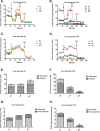Distinct age and differentiation-state dependent metabolic profiles of oligodendrocytes under optimal and stress conditions
- PMID: 28792512
- PMCID: PMC5549710
- DOI: 10.1371/journal.pone.0182372
Distinct age and differentiation-state dependent metabolic profiles of oligodendrocytes under optimal and stress conditions
Abstract
Within the microenvironment of multiple sclerosis lesions, oligodendrocytes are subject to metabolic stress reflecting effects of focal ischemia and inflammation. Previous studies have shown that under optimal conditions in vitro, the respiratory activity of human adult brain-derived oligodendrocytes is lower and more predominantly glycolytic compared to oligodendrocytes differentiated in vitro from post natal rat brain oligodendrocyte progenitor cells. In response to sub-lethal metabolic stress, adult human oligodendrocytes reduce overall energy production rate impacting the capacity to maintain myelination. Here, we directly compare the metabolic profiles of oligodendrocytes derived from adult rat brain with oligodendrocytes newly differentiated in vitro from oligodendrocyte progenitor cells obtained from the post natal rat brain, under both optimal culture and metabolic stress (low/no glucose) conditions. Oxygen consumption and extracellular acidification rates were measured using a Seahorse extracellular flux analyzer. Our findings indicate that under optimal conditions, adult rat oligodendrocytes preferentially use glycolysis whereas newly differentiated post natal rat oligodendrocytes, and the oligodendrocyte progenitor cells from which they are derived, mainly utilize oxidative phosphorylation to produce ATP. Metabolic stress increases the rate of ATP production via oxidative phosphorylation and significantly reduces glycolysis in adult oligodendrocytes. The rate of ATP production was relatively unchanged in newly differentiated post natal oligodendrocytes under these stress conditions, while it was significantly reduced in oligodendrocyte progenitor cells. Our study indicates that both age and maturation influence the metabolic profile under optimal and stressed conditions, emphasizing the need to consider these variables for in vitro studies that aim to model adult human disease.
Conflict of interest statement
Figures





References
-
- Yeung MS, Zdunek S, Bergmann O, Bernard S, Salehpour M, Alkass K, et al. Dynamics of oligodendrocyte generation and myelination in the human brain. Cell. 2014;159(4):766–74. doi: 10.1016/j.cell.2014.10.011 - DOI - PubMed
-
- Franklin RJ, Goldman SA. Glia Disease and Repair-Remyelination. Cold Spring Harb Perspect Biol. 2015;7(7):a020594 doi: 10.1101/cshperspect.a020594 - DOI - PMC - PubMed
-
- Sanchez-Abarca LI, Tabernero A, Medina JM. Oligodendrocytes use lactate as a source of energy and as a precursor of lipids. Glia. 2001;36(3):321–9. - PubMed
MeSH terms
Substances
LinkOut - more resources
Full Text Sources
Other Literature Sources

